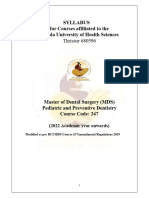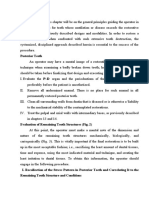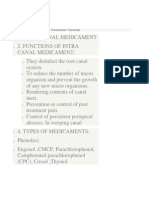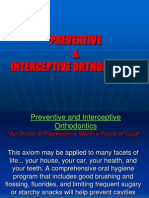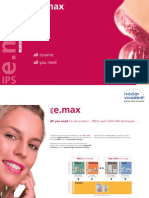Biological Restorations in Children: January 2016
Biological Restorations in Children: January 2016
Uploaded by
Mel LlerenaCopyright:
Available Formats
Biological Restorations in Children: January 2016
Biological Restorations in Children: January 2016
Uploaded by
Mel LlerenaOriginal Title
Copyright
Available Formats
Share this document
Did you find this document useful?
Is this content inappropriate?
Copyright:
Available Formats
Biological Restorations in Children: January 2016
Biological Restorations in Children: January 2016
Uploaded by
Mel LlerenaCopyright:
Available Formats
See discussions, stats, and author profiles for this publication at: https://www.researchgate.
net/publication/296455579
Biological Restorations in Children
Article · January 2016
CITATIONS READS
0 217
1 author:
Faizal C Peedikayil
Kannur Dental College, Anjarakandy,
49 PUBLICATIONS 173 CITATIONS
SEE PROFILE
Some of the authors of this publication are also working on these related projects:
'Comparision of Candida species isolated from children with and without Early Childhood Caries; A Descriptive Cross Sectional Study' View project
Preventive pediatric dental care View project
All content following this page was uploaded by Faizal C Peedikayil on 01 March 2016.
The user has requested enhancement of the downloaded file.
Technique KDJ – Kerala Dental Journal
Biological restorations in children
* Seena John, ** Faizal C. Peedikayil, *** Vimal Remy
Abstract and Bianchi in 1991. It is defined as an procedure, obtaining healthy periodontal
“alternative technique that uses adhesive attachment and maintenance of the
An increasing demand for esthetics capabilities of materials in combination original tooth contours and translucence.
has led to new innovations and
with strategic placement of parts of The reattachment technique was
techniques in dental restorations in
anterior teeth. Tooth structure may human extracted teeth”2,3. first described in 1964 by Chosak
be used as an alternative to restore The technique of bonding tooth and Eidelaman. At that time, it was
fractured segments, grossly carious fragments was first proposed to repair considered as a provisional restoration
teeth etc. The tooth fragments can permanent teeth with the patient’s own due to the low bond strength values
be obtained from patients own tooth fractured crown. However, it also has achieved by the adhesive systems.
or from tooth bank. The restorations been performed to restore crowns However, the remarkable advancement
using these teeth are termed as
severely destroyed by carious disease, of the adhesive systems and resin
biological restoration. This article
discusses the different aspects of using fragments from another patient. composites has made there attachment
biological restorations. Moreover, extracted permanent teeth of tooth fragments a procedure that is
have also been employed in removable no longer a provisional restoration, but
Key words: Biological Restorations,
and fixed prostheses. Natural crowns rather a treatment offering favourable
Tooth Fragment,Paediatric Dentistry.
and roots, obtained from a tooth bank, prognosis.(Fig. 1) This procedure found
KDJ 2016 | Vol. 39 | No. 1 | Pg 30-32 have been used for several clinical and a strong argument in a conservative
laboratory procedures. 4 philosophy, since it does not require
Although the technique is simple, excessive wear of the healthy tooth
►► Introduction it requires the professional ability to structure and do not make unfeasible
Fractured tooth crowns, Primary prepare and adapt the natural crowns any other later possible restorative
teeth with extensive carious lesions are and intra canal posts. Parents must be treatment 4 - 6. J. O. Andreasen7 states
routinely observed in clinical practice. informed of, accept, and consent to the that the tooth reattachment procedure
Tooth material loss at an early age may use of teeth from a tooth bank. Teeth may importantly serve as a transitional
not only lead to establishment of neuro- from a trustworthy tooth bank must treatment alternative for pre-teens or
muscular imbalance leading to decreased be available. teenage patients to postpone definitive
masticatory efficacy but also phonetic treatment until an age where gingival
and esthetic problems, development Fragment reattachment margin contours are relatively stable.
of parafunctional, psychological Traumatic injuries most commonly Patients should be appraised of the
problems.1 To restore them is thus affect maxillary incisors. The most advantages and disadvantages and should
a challenge for the clinician. Diverse common teeth effected are central make an informed decision based on the
treatment options are available today like, incisors and lateral incisors due to their dentist’s recommended treatment
composite restorations stainless steel anterior position and protrusion caused Current adhesive agents provide
crowns, cheng crowns, dura crowns, strip by the eruptive process. Reattachment of sufficient bonding strengths to withstand
crowns, glastech crowns, pedo jacket a tooth fragment should be preferable the slow loading from masticatory
crowns etc. Out of the various treatment for restoring fractured teeth. There are stresses eventhough this bonded
options available to rehabilitate severely several advantages in this treatment interface is undeniably susceptible to the
destroyed tooth crowns, conservatively such as obtaining aesthetic in a single effects of cyclic fatigue and hydrolytic
and biologically, several authors have appointment, being a more conservative degradation over time. However, it
suggested the use of tooth structure as a
restorative material.1,2 The term biologic *PG Student, ** Professor & HOD, Department of Pedodontics and Preventive Dentistry, *** Senior Lecturer, Dept of
restoration was introduced by Santos Endodontics, Kannur Dental College, Kannur, Kerala State, India Corresponding author: Dr. Faizal C. Peedikayil,
Email drfaizalcp@gmail.com
30 KDJ – Vol. 39 • No. 1 • January 2016
Biological restorations in children
appears that improvements in the luting and/or bonding should be followed in the human tooth bank. Collected
systems employed and a greater knowledge of the factors samples should be scaled, polished and freed of soft tissues
influencing restoration longevity should serve to enhance the and periodontal remnants. Pulps have to be removed and
potential for success of reattachment techniques in the future.8 complete biological preparation is to be done. Teeth are then
stored at 4 degree centigrade in HBSS with donor identification
Biological crowns till the time of its use. 9,10
The use of extracted teeth as biological restoration It is important that the parents are informed that the
constitutes a viable restorative alternative for teeth with tooth fragments used for biological restoration are previously
extensive coronal destruction. This technique is simple, submitted to a rigorous sterilization process that completely
provides excellent esthetics as well as preserves natural tooth eliminates any risk of contamination or disease transmission
colour compared to composite resins and stainless steel to the child receiving the fragment. Presently, secure methods
crowns, allows the preservation of sound tooth structure and of sterilization and storage are available to ensure the safety
has low cost. The enamel of the biologically restored tooth of teeth or tooth fragments coming from tooth banks Several
has physiologic wear and offers superficial smoothness and materials have been used for bonding dental fragments to
cervical adaptation compatible with those of surrounding cavities, e.g., adhesive systems, composite resins, glass ionomer
teeth. Biological restorations not only mimic the missing part cements and dual-cure resin cements. Since the Tooth fragment
of the oral structures, but are also biofunctional.5,6 which was taken was large, it was concerned that optimal
The length of each appointment is reduced because light-curing would not be achieved at the cavity gingival
natural teeth are prepared previously. Clinical chair time for margin. Thus, dual-cure resin-based cement was used to
fragment bonding procedures is relatively short, which is a enhance polymerization at this region in addition to filling
merit especially while dealing with paediatric patients Resin any possible gaps existing at tooth/fragment interface with
composite restorations do not present these advantages and composite resin only.3,4,5
can allow staining and plaque formation on their surfaces. 2,3 Biological restoration technique using tooth fragments has
Disadvantages of the biological crown restoration technique a practical clinical applicability and is a viable, cost-effective
include the difficulty in obtaining teeth with the required restorative procedure for primary teeth with severely damaged
coronal dimensions and characteristics, problems inherent to crowns. In the present case, the use of biological restoration
indirect restorations and matching fragment colour with tooth with natural crown resulted in clinical success as well as
remnant colour. Also, having teeth from other people’s teeth recovered the proper functional anatomy of the tooth. Finally
in their mouth is not a pleasant idea for some patients and the choice of restorative technique depends upon the operator
many of them refuse to receive this treatment However, all preferences, esthetic demands by the parents and child’s
these factors are not contraindications of the technique2,3,6,8. behavior that affect the ultimate outcome of whichever
Biological restoration used teeth from the Human Tooth restorative material chosen.
Bank are used as natural posts & crowns.2,7 The selected tooth
from the tooth bank is reshaped, roots strengthened by retro ►► Conclusion
filling with flowable composites and autoclaved for 30min at The constant evolution of Restorative Odontology is
121 degree centigrade and 15 lbs pressure before cementation.9 creating a new sight. In this short review represents the
Other factors of concern while using biologic restoration functional recuperation of a tooth, through the use of a
is that Universal protocol of consent, storage and sterilization endogenous dental fragment, a technique known as Biological
Fig. 1: Tooth fragment reattachment
KDJ – Vol. 39 • No. 1 • January 2016 31
Seena John
restoration. With highly satisfactory results obtained in many 4. Saha R, Malik P. Paediatric aesthetic dentistry: a review. European
case reports, we conclude that this technique can be considered Journal of Paediatric Dentistry.2012; vol. 13(1):6-12.
as alternative to all others and can be carried out quickly and 5. Am Botelho, Kta T, Correa-Faria P1, Lns M,Viana M. Esthetic–
Functional Recovery Of Permanent Posterior Tooth Using Prima
inexpensively. Autogenous Biologica lrestoration Journal Of Indian Society
Of Pedodontics And Preventive Dentistry. 2012 Oct - Dec;
►► References 4(30):333-336.
1. Mathur S, Rahul C, Pandit I K, Srivastava N, Gugnani N. 6. Grewal N, Reeshu S.Case Report Biological restoration:An
BiologicalRestoration of a Grossly Decayed Deciduous Mandibular alternative Esthetic Treatment For Restoration Of Severly Multilated
Molar. Journal of Clinical and Diagnostic Research. 2012 Primary Anterior Teeth International Journal Of ClinicalPediatric
February;6(1): 139-141. Dentistry 2008.;1(1):42-47.
2. Sanches K, CarvalFabrício K D, FilhPaulo N,Sada A 7. Textbook and Color Atlas of Traumatic Injuries to the Teeth, 4th
F,WanderleyGarcia De Paula E S,Alexandra, Mussolino D Q. Edition, Jens O. Andreasen, FrancesM. Andreasen Lars Andersson,
Biological Restorations As A Treatment Optionfor Primary Molars July 2007, Wiley-Blackwell
With Extensive Coronal destruction - Report Of Two Casesbraz 8 Attila IO, Cenk MHA, Serdar MT.Multidisciplinary approach to the
Dent J (2007) 18(3): 248-252. rehabilitation of a crown –root fracture for immediate esthetics.
3. Das U K, Maiti N. Nature’s Own Alternative – Restoration Dent traumatol. 2006;22(1):48-52.).
With Biological Crowns. International Journal Of Pediatric 9 Habiltz S, et al. Nanoindentation and storage of teeth. J Biomech
Dentistry.2014april-June;3(2):144-149. 2002; 35(7):995 98.
10 Imparato JCP. Bank human teeth. Curitiba: Publi sher May, 2003.
The Largest
Dental Portal of Kerala
Log on
www.idakerala.com
for IDA Activities, Reports,
Publication etc...
32 KDJ – Vol. 39 • No. 1 • January 2016
View publication stats
You might also like
- All Ceramic Inlays and Onlays For Posterior TeethDocument11 pagesAll Ceramic Inlays and Onlays For Posterior TeethNajeeb Ullah100% (1)
- Fixed Orthodontic Appliances: A Practical GuideFrom EverandFixed Orthodontic Appliances: A Practical GuideRating: 1 out of 5 stars1/5 (1)
- Textbook of Pediatric Dentistry-3rd EditionDocument18 pagesTextbook of Pediatric Dentistry-3rd EditionAnna NgNo ratings yet
- Enamel Acid Etching - A ReviewDocument8 pagesEnamel Acid Etching - A ReviewAmee PatelNo ratings yet
- Mds SyllabusDocument78 pagesMds SyllabusFrancis PrathyushaNo ratings yet
- Ultrasonic Periodontal Debridement: Theory and TechniqueFrom EverandUltrasonic Periodontal Debridement: Theory and TechniqueRating: 2.5 out of 5 stars2.5/5 (2)
- Crown LengtheningDocument89 pagesCrown LengtheningMohamadAl-askar83% (6)
- Lasers in Pediatric Dentistry - 2Document82 pagesLasers in Pediatric Dentistry - 2Shameena KnNo ratings yet
- Avulsion: DEFINITION: - Tooth Avulsion (Exarticulation) Implies Total Displacement of The ToothDocument39 pagesAvulsion: DEFINITION: - Tooth Avulsion (Exarticulation) Implies Total Displacement of The Toothshailesh_shenoyNo ratings yet
- Cementoenamel Junction An InsightDocument6 pagesCementoenamel Junction An InsightJessica ChenNo ratings yet
- Epidemiology of Dental Caries 2020Document58 pagesEpidemiology of Dental Caries 2020zahra.mohmed2816No ratings yet
- Case Report: M E C C C S AC RDocument3 pagesCase Report: M E C C C S AC RRaja Dean Collin SiagianNo ratings yet
- Traumatic Injuries To The Teeth4541Document114 pagesTraumatic Injuries To The Teeth4541Irfan Ali100% (1)
- MDS Pediatric and Preventive DentistryDocument61 pagesMDS Pediatric and Preventive DentistryfathimapedoNo ratings yet
- Self Applied Topical Fluorides ClassDocument23 pagesSelf Applied Topical Fluorides ClassultraswamyNo ratings yet
- Pulp Therapy of Non-Vital Teeth (Pulpectomy)Document27 pagesPulp Therapy of Non-Vital Teeth (Pulpectomy)Mahmoud A. Zoghbor100% (1)
- Epidemiologi Dental CariesDocument21 pagesEpidemiologi Dental CariesSampahAjaNo ratings yet
- Cleft Lip and Palate in Paediatric DentistryDocument29 pagesCleft Lip and Palate in Paediatric DentistryAkshay Sreeraman KecheryNo ratings yet
- Conscious Sedation in Pediatric Dentistry A ReviewDocument4 pagesConscious Sedation in Pediatric Dentistry A Reviewjyothi shashidharNo ratings yet
- (RestoDent) Dentin-Pulp ComplexDocument28 pages(RestoDent) Dentin-Pulp ComplexZara Sebastianne GarciaNo ratings yet
- Crowding 180601115625 PDFDocument109 pagesCrowding 180601115625 PDFVishal SharmaNo ratings yet
- Non-Restorative Cavity TreatmentDocument8 pagesNon-Restorative Cavity TreatmentQurrat-ul-AinNo ratings yet
- Gingival and Periodontal Diseases in ChildrenDocument80 pagesGingival and Periodontal Diseases in ChildrenSonam RawatNo ratings yet
- Caries VaccineDocument30 pagesCaries Vaccinemangesh andhare100% (1)
- Iii Bds Pediatric and Preventive DentistryDocument7 pagesIii Bds Pediatric and Preventive DentistryHARSH KUMARNo ratings yet
- Dental Injuries - Tony SkapetisDocument32 pagesDental Injuries - Tony SkapetisHesti RahayuNo ratings yet
- Estrogenicity of CompositesDocument8 pagesEstrogenicity of CompositesSubhashini RajshekarNo ratings yet
- Local Anesthesia in Peadiatric Dentistry: Presented By: DR - Walija Ansari & Dr. Yousuf Ahmed KhanDocument24 pagesLocal Anesthesia in Peadiatric Dentistry: Presented By: DR - Walija Ansari & Dr. Yousuf Ahmed KhanChaudhry Abdullah DeuNo ratings yet
- Biological Properties of Dental Materials 1-General Dentistry / Orthodontic Courses by Indian Dental AcademyDocument76 pagesBiological Properties of Dental Materials 1-General Dentistry / Orthodontic Courses by Indian Dental Academyindian dental academyNo ratings yet
- Department of Pedodontics: Submitted By: Shayoni Sen Bds Ivth YearDocument29 pagesDepartment of Pedodontics: Submitted By: Shayoni Sen Bds Ivth YearFarzana ShereenNo ratings yet
- Etched Cast RestorationsDocument41 pagesEtched Cast Restorationssharanya chekkarrajNo ratings yet
- DentinDocument89 pagesDentinDr Zadeno kithanNo ratings yet
- Space Regainers in Pediatric DentistryDocument6 pagesSpace Regainers in Pediatric DentistryDiba Eka DiputriNo ratings yet
- Factors Influencing Successful Pulp CappingDocument7 pagesFactors Influencing Successful Pulp CappingamandaNo ratings yet
- Hypomineralised Second Primary Molars May Be Indicative of Future Molar Incisor Hypomineralisation PDFDocument6 pagesHypomineralised Second Primary Molars May Be Indicative of Future Molar Incisor Hypomineralisation PDFnha khoa NHƯ NGỌCNo ratings yet
- Deep Caries ManagementDocument5 pagesDeep Caries ManagementKarim MohamedNo ratings yet
- Badly Broken MarzoukDocument68 pagesBadly Broken MarzoukHend MohamedNo ratings yet
- Dental Consideration of Medically Compromised ChildrenDocument163 pagesDental Consideration of Medically Compromised Childrenpriti adsulNo ratings yet
- DR Nick Lekic - Space MaintainersDocument35 pagesDR Nick Lekic - Space MaintainersanatomimanusiaNo ratings yet
- 10 Pulp and Periapical DiseaseDocument7 pages10 Pulp and Periapical Diseasedoctorgame085100% (1)
- Oral Pre Cancerous LesionsDocument49 pagesOral Pre Cancerous LesionsAmit MishraNo ratings yet
- Aae Systemic AntibioticsDocument8 pagesAae Systemic AntibioticsIulia CiobanuNo ratings yet
- Journal Laser and Its Use in Pediatric Dentistry A ReviewDocument5 pagesJournal Laser and Its Use in Pediatric Dentistry A ReviewTiaraNo ratings yet
- The Spectrum of Composites:New Techniques and Materials: Background. Clinical ImplicationsDocument5 pagesThe Spectrum of Composites:New Techniques and Materials: Background. Clinical ImplicationsThant Sin ChangNo ratings yet
- Intra Canal Medicaments-2Document58 pagesIntra Canal Medicaments-2FadilaNo ratings yet
- Pedodontics Notes 2Document1 pagePedodontics Notes 2Prince AhmedNo ratings yet
- Post Insertion InstructionsDocument23 pagesPost Insertion InstructionsAnkita Reddy VallapNo ratings yet
- Evidence-Based Dentistry What's NewDocument5 pagesEvidence-Based Dentistry What's NewGanisht AzmiNo ratings yet
- CDE Fundamentals - in - Tooth - Preparation 16 12 14Document87 pagesCDE Fundamentals - in - Tooth - Preparation 16 12 14Saad khanNo ratings yet
- Stainless Steel CrownDocument12 pagesStainless Steel CrownAndreas WallaceNo ratings yet
- Intra Canal MedicamentsDocument14 pagesIntra Canal MedicamentsS Noshin ShimiNo ratings yet
- Obturation Techniques in ChildDocument6 pagesObturation Techniques in ChildMonisha100% (1)
- Minimally Invasive Dentistr YDocument61 pagesMinimally Invasive Dentistr YnishthaNo ratings yet
- Irrigating Solution in Pediatric DentistryDocument12 pagesIrrigating Solution in Pediatric DentistryshireenopalNo ratings yet
- Hall TechniqueDocument19 pagesHall TechniqueanatomimanusiaNo ratings yet
- Preventive & Interceptive OrthodonticsDocument50 pagesPreventive & Interceptive OrthodonticsDeebah ChoudharyNo ratings yet
- Surgical Complications in Oral Implantology: Etiology, Prevention, and ManagementFrom EverandSurgical Complications in Oral Implantology: Etiology, Prevention, and ManagementNo ratings yet
- Basic Level of Dental Resins - Material Science & Technology: 4th Edition, 2nd VersionFrom EverandBasic Level of Dental Resins - Material Science & Technology: 4th Edition, 2nd VersionNo ratings yet
- Minimally Invasive Periodontal Therapy: Clinical Techniques and Visualization TechnologyFrom EverandMinimally Invasive Periodontal Therapy: Clinical Techniques and Visualization TechnologyNo ratings yet
- Anatomic Position of PointsDocument78 pagesAnatomic Position of PointsMel LlerenaNo ratings yet
- Mouthwashes-An Overview of Current Knowledge: January 2013Document6 pagesMouthwashes-An Overview of Current Knowledge: January 2013Mel LlerenaNo ratings yet
- Restorations in Primary Teeth: A Systematic Review On Survival and Reasons For FailuresDocument17 pagesRestorations in Primary Teeth: A Systematic Review On Survival and Reasons For FailuresMel LlerenaNo ratings yet
- Cochrane: LibraryDocument40 pagesCochrane: LibraryMel LlerenaNo ratings yet
- Direct Versus Indirect Inlayonlay Composite Restorations in Posterior Teeth. A Systematic Review and Meta-Analysis PDFDocument10 pagesDirect Versus Indirect Inlayonlay Composite Restorations in Posterior Teeth. A Systematic Review and Meta-Analysis PDFMel LlerenaNo ratings yet
- Management of Endodontically Treated ToothDocument65 pagesManagement of Endodontically Treated ToothHoney Bragado100% (1)
- Fracture Resistance of Molars Restored With Different Types of Ceramic Partial Coverage Restorations. An In-Vitro StudyDocument92 pagesFracture Resistance of Molars Restored With Different Types of Ceramic Partial Coverage Restorations. An In-Vitro StudySara Faris100% (1)
- Minimally Invasive Vertical Preparation Design For Ceramic VeneersDocument12 pagesMinimally Invasive Vertical Preparation Design For Ceramic VeneersdanielaNo ratings yet
- Cad Cam ReviewDocument5 pagesCad Cam ReviewnabeghNo ratings yet
- Ting-Ling Chang, DDS Clinical Professor Division of Advanced Prosthodontics UCLA School of DentistryDocument32 pagesTing-Ling Chang, DDS Clinical Professor Division of Advanced Prosthodontics UCLA School of DentistryRami Mohammed Alhomrany100% (2)
- Prosthetic Dentistry 1916Document1,248 pagesProsthetic Dentistry 1916lotusfrog100% (1)
- Principles of Tooth Preparation: (Lecture or Part-2)Document15 pagesPrinciples of Tooth Preparation: (Lecture or Part-2)arafapoem elmoughrabiNo ratings yet
- Brochure GC Gold LabelDocument6 pagesBrochure GC Gold LabelIka Kusumawati0% (1)
- Young Practitioners Guide To PeriodontologyDocument36 pagesYoung Practitioners Guide To PeriodontologyAndrea Law100% (3)
- How To Take A Good Impression (Crown and Bridge)Document3 pagesHow To Take A Good Impression (Crown and Bridge)mutuora100% (1)
- The International Journal of Periodontics & Restorative DentistryDocument8 pagesThe International Journal of Periodontics & Restorative DentistryBagis Emre GulNo ratings yet
- Laboratory Manual Endn 832-1 Endodontics I Spring Quarter 2013Document56 pagesLaboratory Manual Endn 832-1 Endodontics I Spring Quarter 2013Jessa Mae Ferolino100% (2)
- Adult OrthodonticsDocument192 pagesAdult Orthodonticsnikita100% (4)
- 2 - Evaluation of Bond Strength and Thickness of Adhesive Layer According To The Techniques of Applying Adhesives in Composite Resin RestorationsDocument7 pages2 - Evaluation of Bond Strength and Thickness of Adhesive Layer According To The Techniques of Applying Adhesives in Composite Resin Restorationskochikaghochi100% (1)
- ADA Glossary Edition 9 2010Document87 pagesADA Glossary Edition 9 2010刘芳妤No ratings yet
- International Journal of Dental Science and Innovative Research (IJDSIR)Document7 pagesInternational Journal of Dental Science and Innovative Research (IJDSIR)yusfaNo ratings yet
- Inlay & Onlay NotesDocument4 pagesInlay & Onlay Notesdent in dentistNo ratings yet
- Fixed ProsthodonticsDocument5 pagesFixed ProsthodonticsSnehal UpadhyayNo ratings yet
- IPS E-Max PressDocument40 pagesIPS E-Max PressFabio WenoNo ratings yet
- Case Report Orthodontic Treatment of Unilateral Cleft Lip and Alveolus Patient With Maxillary Lateral Incisor Missing: Case ReportDocument7 pagesCase Report Orthodontic Treatment of Unilateral Cleft Lip and Alveolus Patient With Maxillary Lateral Incisor Missing: Case ReportAmeria Briliana ShoumiNo ratings yet
- Class 4 Composite RepairDocument8 pagesClass 4 Composite RepairventynataliaNo ratings yet
- Lecture 3, Composite (Script)Document13 pagesLecture 3, Composite (Script)JustDen09No ratings yet
- Occlusal Adjustment by Selective Grinding Use of An Anterior Deprogrammer PDFDocument7 pagesOcclusal Adjustment by Selective Grinding Use of An Anterior Deprogrammer PDFEsme ValenciaNo ratings yet
- 4 - Diagnosis and Treatment PlanningDocument8 pages4 - Diagnosis and Treatment PlanningPrince Ahmed100% (1)
- Minimall Tooth Preparation Garil GurelDocument13 pagesMinimall Tooth Preparation Garil GurelMónica BecerraNo ratings yet
- Estudio Ce - Novation ZirconioDocument8 pagesEstudio Ce - Novation ZirconioHugo MoralesNo ratings yet
- Emax System Brochure Za enDocument8 pagesEmax System Brochure Za enAbdou MessaoudNo ratings yet
- Assessment of Fracture Resistance of Endocrown Constructed of Two Different Materials Compared To Conventional Post and Core Retained CrownDocument20 pagesAssessment of Fracture Resistance of Endocrown Constructed of Two Different Materials Compared To Conventional Post and Core Retained CrownDr-Ahmed Yahya ElRefaayNo ratings yet
















